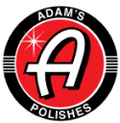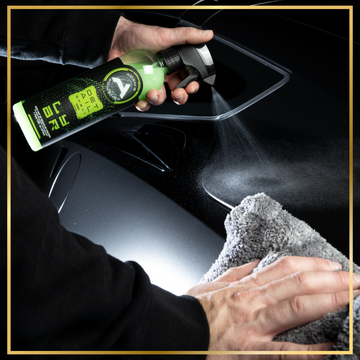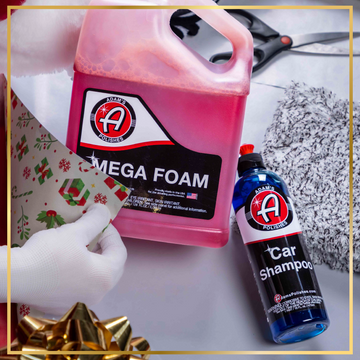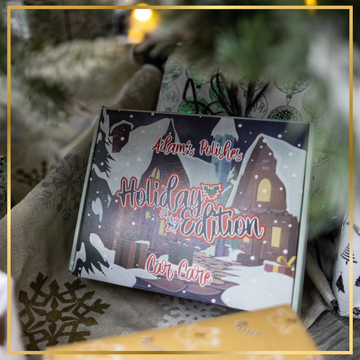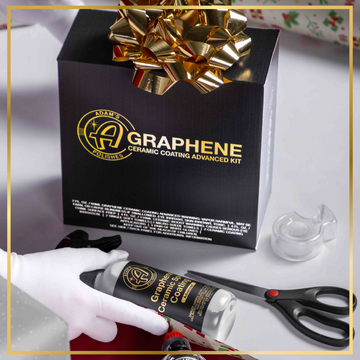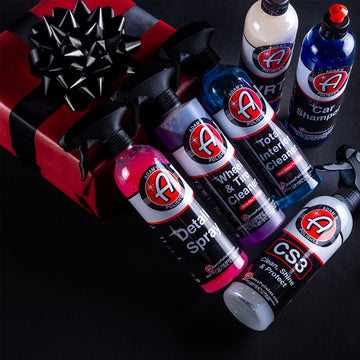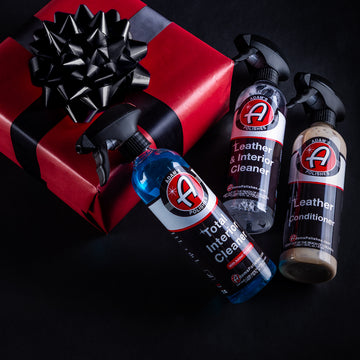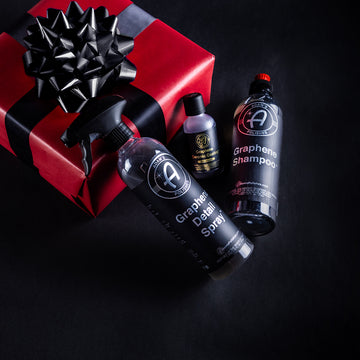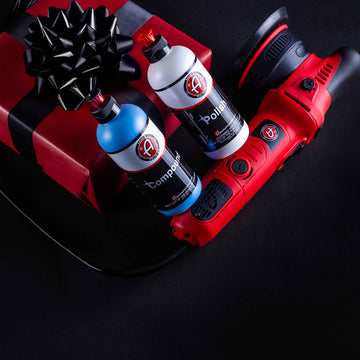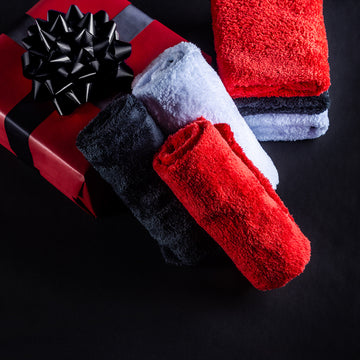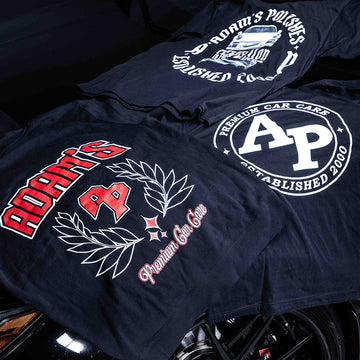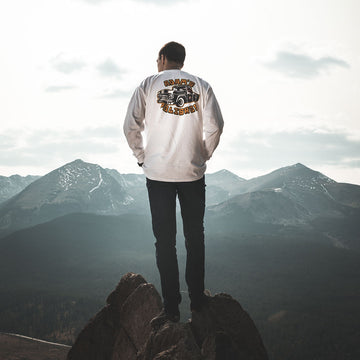Some very common questions that we receive on almost a weekly basis are variations of “What products do you have for a black car?” and “What is your best wax for a black car?” The reality is that our products work just as well on black paint as they do any other color vehicle. Black paint is no different than any other color paint - it just shows defects more easily, and therefore, can be more challenging to clean and maintain properly without the right process and products. Black paint doesn't attract dirt, dust, smudges, finger prints, water spots, haze, oxidation, or scratches faster than any other color paint, but it seems like it does because it amplifies imperfections since they stand out much more on a black surface compared to another color like silver, gray, metallic brown, orange, or light green, or pearl white - where the dirt and dust may blend into the color better or swirl marks and scratches may not be as noticeable.
Many of the best tools for detailing your black vehicle are the same as other paint - but they're especially critical on black since it's so easy to see every water spot, every swirl, and every bit of dirt. Using the proper processes and techniques for cleaning and caring for a black vehicle are crucial to ensuring that it looks its best for as long as possible in between more in-depth detailing sessions. In this blog entry, we’ll explain the Three P’s of owning and detailing a black car: 1. (Perfecting) the Finish 2. (Preserving) The Paint 3. (Preventing) Damage - Water Spots and Scratches. We will also discuss some additional safety measures such as Proper Washing, Drying, and Maintenance to keep that black mirror finish. First thing’s first, let’s jump into making that paint shine!
How To Perfect
A Black Vehicle
Introduction
Perfecting The Finish
You want your black car to look its best, so in order to achieve that, you will need to do paint correction to the finish. By “paint correction”, in the detailing world we do not mean repainting panels at a body shop, repairing dents or rust, and so on. Paint correction in our terms is using a random orbital machine polisher to safely remove defects in the vehicle’s finish, such as haze, swirl marks or spider webbing, marring, and light scratches by using different combinations of cutting and finishing compounds, pads, and polishes. These product combinations will smooth and level defects by removing microscopic layers of clear coat to bring back incredible levels and gloss and depth to the paint, rather than “filling in” or hiding these defects temporarily with something like a wax or glaze. Some products from other brands that are tailored to black paint have dyes mixed into their formula, which attempt to temporarily hide or mask defects rather than fix the problems. These dyes will wear off after a few washes, and the finish will be right back to showing every swirl mark and scratch. By compounding and polishing the surface instead, you are doing it right the first time by correcting the finish.
Paint Correction/Machine Polishing
After you have thoroughly washed and decontaminated the paint, you are ready to move onto compounding out the more serious flaws such as water spots, oxidation, and scratches. For a quick refresher on how to decontaminate a vehicle using a Clay Bar or Clay Mitt, you can review this video here: How To Properly Decontaminate A Vehicle With Clay
True shine comes from proper paint correction. When using a random orbital polisher, you always want to start in a small test area that represents the overall wear and finish of the vehicle. This will usually be a small spot on the hood, fenders, or trunk, since they are at your sight-line and defects will stand out more easily. You do not want to compound and polish the entire vehicle, only to move it outside and discover that you are not happy with the results and need to start over from the beginning with a more aggressive cutting pad for instance.
When paint-correcting a black vehicle with more severe swirl marks and heavier haze or oxidation, you will almost always need to perform a Two-Step Paint Correction with Compound and then Polish at minimum. Our Adam’s SK Pro 12mm Swirl Killer Polisher Complete Kit has everything you need to bring your vehicle’s paint to its best potential. For someone that is new to machine polishing or may have never held a polisher before, the 12mm polisher is more compact and nimble, allowing you to reach more tight areas of the vehicle while not feeling as big and intimidating as the larger SK Pro 15mm machine. The SK Pro 12mm does just as much correction and perfection as the larger 15mm, so it is the machine that Adam and our staff recommend if you are just starting out and only have enough budget for one polisher - it will just take longer to polish the whole vehicle.
Starting out with a Microfiber Cutting Pad or Blue Foam Pad with the color-coded blue Compound will remove the bigger defects; however, on dark colors like black, compounding can leave behind micro-marring and a slight hazy or shimmering look to the finish. On careful inspection, you will see this as thousands of tiny 1-2mm micro-scratches rather than the larger swirl marks that were present before. These micro-scratches are present on lighter colors after compounding as well, but they are typically far less noticeable, or they may not even be visible at all on colors such as silver, white, and other lighter metallic colors. The next step is to refine, or perfect, the surface as much as possible using the White Foam Pad and color-coded white Polish. Our Polish will remove these tiny micro-scratches, giving as much gloss, clarity, and depth to the paint as possible. It finishes amazingly, with no dust, the residue wipes away very easily, and the juicy-fruit scent makes using it an enjoyable experience. An overview of the entire paint correction process can be found in the video here: Polishing 101 | Adam's Polishes
Pro-Tip: Certain clear coats can be very soft and easy to scratch when wiping away Compound and Polish with the wrong towel, or a dirty towel. The clear coat can be even more susceptible at this point, since you have introduced some heat to the paint with the machine, pad, and chemical. It is critical to have new or very clean towels at this point in the process, so that you do not reintroduce unnecessary scratches into the black finish using cheap bulk-buy towels.
Preserve The Finish
Now that you’ve spent several hours perfecting the paint with your Swirl Killer Polishers, you need to preserve all of that hard work with durable protection. Over the last few years, ceramic coatings have become more and more common in the detailing regimen, but many are still hesitant to try them, or do not think they have the necessary time or skill set to apply a coating successfully. While most ceramic coatings have a more-involved application process and usually require 24-hour cure times indoors before they can be exposed to water or moisture, our Graphene Ceramic Spray Coating™ Advanced takes the time, worry, and difficulty out of the equation and replaces them with a very easy-to-use spray that still provides very robust protection for up to 1-2 years.
Graphene Ceramic Spray Coating™ Advanced
With respect to protecting black paint, you will want more durable protection than what you can achieve with a wax. Black paint can reach temperatures of 190℉ or higher on a hot, sunny, summer day - temperatures at which waxes begin to melt and break down, where a product like Graphene Ceramic Spray Coating™ Advanced will not be affected. It provides a protection layer that is harder than a clear coat, that once cured, will offer increased resistance to swirl marks and scratches. Scratches can and will still occur, but there will be more resistance, and they will be easier to paint-correct later on, since they may only be superficial into the coating layer and not deeper down into the clear coat.
Graphene Ceramic Spray Coating™ Advanced is very easy to apply. Once you apply and remove it on one panel, your fears of ceramic coatings will be gone. Customers at our shows will be shocked and say things like “It can’t be that easy!” but it really is that easy. After misting a few sprays into an applicator and spreading it onto the paint, it sets up, or flashes, in a matter of seconds, with a very apparent oily, rainbow-look. After a few minutes, the oil-slick-look will begin to turn to a more cloudy or clear look, and then you buff away the residue by hand with a plush microfiber towel like our Borderless Grey Towel. Gloss levels are extremely high and it only needs about 4-6 hours before the surface can become wet with water or dew/moisture. The hydrophobics, water beading, and water repelling performance are as exceptional as the 7+ year Graphene Ceramic Coating™ 60ml bottle that we offer but at a thinner overall layer of protection. This lower percentage of active resin is why it is easier to apply and lasts 1-2 years rather than 7+ years, but it still allows for easier washing since contamination will not stick as easily, and much more durability and longevity than a wax since it can only be removed with abrasion over time or with a machine polisher.
Preventing Damage - Water Spots and Scratches
As we mentioned earlier, black and other darker paints show defects more easily than other paint colors, so you will want to minimize the amount that you are actually touching the paint finish. Using a pressure washer to safely blast away as much dirt and debris as possible before even touching the paint with a wash pad or wash mitt is one vital step to avoid introducing new scratches and swirl marks while washing the vehicle. Water spots are a common nuisance for almost everyone at some point. There are some unavoidable situations, like water spots from water sprinklers at the office parking lot, or rainwater from a flash rainstorm that then etches into the surface if the hot sun pops up immediately afterward; however, you can eliminate water spots from hard water in the washing process. Having deionized water for a spot-free rinse is another crucial step in owning a black car, so that you avoid unsightly water spots when washing and drying your vehicle.
Pro Series Pressure Washer - Safer Washing
Many people think that using a pressure washer on your vehicle can cause more harm than good, but we are here to debunk that statement. A pressure washer is one of the most important tools you can own when it comes to cleaning your car. When used properly, a pressure washer is a very effective and safe way to deep-clean the exterior of your vehicle, removing more dirt, debris, bug splatter, bird droppings, and other road grime than your standard garden hose. A pressure washer like the Adam’s Pro-Series Pressure Washer typically has 30-40x more pressure than the water supply from your household water hose. This increased pressure allows you to more easily remove more dirt from vehicle surfaces, and is still safe when used with the appropriate 40° or 25° tip held at a safe distance of 12-18” away from the vehicle. Spraying too closely to the paint surface or using the incorrect tip (0° or 15°) can result in damage, but when using the tool properly, you will wash your black vehicle more effectively while reducing the chance of scratches. The more dirt you can remove before touching the vehicle with soap and a wash pad, the less chance you have of dirt potentially scratching, swirling, or marring the finish.
Portable Spotless Water Deionizer - Spot-Free Rinsing
The time period during the wash process in which you rinse the soap residue off of the vehicle and begin to dry it is critical, since this is when the potential for water spots is highest. Hard water from the pressure washer or water hose can quickly turn to water spots on a hot, sunny day, so you want to quickly dry in the shade if possible. Drying in shade is not always an option, and using the wrong drying towel or a dirty drying towel can easily swirl the paint of a black vehicle. As mentioned earlier, you want to touch the surface as little as possible on a black car, so the better option for drying without touching is using a water filtration system like Adam’s Portable Water Deionizer.
The Portable Water Deionizer uses resin to filter hard minerals and other contaminants out of your water supply, bringing the Total Dissolved Solids (TDS) in the water down to 0-50 ppm (parts per million). When the water supply is at 0-15 ppm, it allows for the water to evaporate with a spot-free finish, meaning that you do not have to use a drying towel on the vehicle and potentially introduce marring with a dirty towel. Using the bypass valve on the Portable Water Deionizer will allow you to use regular water for the wash, and then flip to clean, deionized water for the rinse, which will allow the resin to last longer in between swapping it out for fresh resin.
Proper Washing Methods
After rinsing with the Pro-Series Pressure Washer, it’s time to remove the remaining dirt, debris, bird droppings, bug splatter, road grime, and more as safely as possible. A Two-Bucket Wash is key when it comes to washing a black vehicle properly. By having one bucket with clean rinse water and a second bucket with your preferred soap like Adam’s Car Shampoo or Mega Foam, and Grit Guards in both, this will greatly reduce wash-induced swirl marks and scratches. Using a top-down approach, once you have done a few passes over the vehicle with your sudsy wash pad, scrub it out into the Rinse Bucket frequently throughout the wash process. The Grit Guard removes the dirt and debris, keeping dirt particles and sediment at the bottom of the Rinse Bucket and out of your Soap Bucket. This way you do not reintroduce dirt back onto the vehicle when you reload the wash pad with more clean suds from the Wash Bucket.
Since you’re already using a pressure washer, add even more safety to the wash process with a Premium Foam Cannon. Connecting a foam cannon to a pressure washer with a high-foaming shampoo like our Mega Foam will flock your vehicle with a thick shaving cream-like foam, to help loosen and lift dirt and grime before you begin the Two Bucket Wash with a wash pad or wash mitt. After a few minutes, the Mega Foam will begin to drip down the vehicle and remove even more dirt that the pressure washer may not have removed. In some instances with light dirt, you may even be able to achieve a contact-free wash.
Proper Drying
The Portable Water Deionizer that we covered earlier will allow for a spot-free rinse; however, there will still be areas that pool up water, such as wiper cowls and roof channels, and areas that trap water, like side mirrors, emblems, lights, grills, gas caps, and more. Touching is scratching in some instances, especially on delicate black paint, so you can use a tool like the Adam’s Air Cannon for touchless drying. The Air Cannon uses filtered, heated air to safely dry and remove water from difficult surfaces, such as wheel spokes and tire treads that can sling water onto the paint, as well as nooks and crannies in body panel seams, mirrors, fender flares, bumpers, and more, to prevent water streaking onto surrounding areas.
Comparison: Leaf Blower vs. Air Cannon
You may wonder “Why do I need an Air Cannon if I already have a leaf blower?” and there are a few key takeaways here:
- Leaf blowers are generally heavy and can fatigue your arms and shoulders by the time you have dried the whole vehicle, compared to just holding the hose of the Air Cannon.
- Gas leaf blowers can leak trace amounts of gas and spit out oil from the exhaust, which can then suck back into the machine and blow out onto your car.
- Some leaf blowers lack air filters, so they can suck dust and debris into the intake and then blow those back out onto the wet vehicle.
Proper Maintenance
We’ve now completed most aspects of how to detail a black car safely and properly, starting with the paint correction process to achieve as much gloss as possible, then protecting that time investment with Graphene Ceramic Spray Coating Advanced, and finally implementing safer washing and drying techniques using the right tools to minimize the amount of touching the vehicle with wash pads and towels. The final crucial factor in keeping a black vehicle looking its best is routine maintenance using the right towels and chemicals. Bulk towels from big box wholesale stores can be much lower quality microfiber towels, and their cheaper cost reflects that. These towels have melted edges, nylon tags, and a thinner pile with a lower GSM rating. All four of these features can aid in scratching up black paint in no time. Using a more delicate and clean plush microfiber towel like our Borderless Grey Towel or Double Soft Towel will greatly reduce the chance of scratching when performing tasks such as wiping away Compound and Polish residue, ceramic coating application, and weekly or monthly maintenance with a product like Detail Spray or CS3.
Comparison: Car Dusters vs. Waterless Wash, CS3, and Detail Spray
Our last topic, but certainly not least, is dust. Dust is always a problem with black cars. We’re sure you’ve heard someone say something like “I just washed my black truck and 4 hours later it’s already dusty again!” This can happen from driving down a dusty road, pollen buildup, or even dust from sitting in a garage for a week or two. Many will break out their big feather dusters and immediately start wiping away multiple times throughout the day at a car show, thinking that they are keeping their vehicle clean, when in actuality, they’re damaging the surface more and more each time they use the duster. Car dusters pick up the dust from the paint and keep these dirt particles right at the end of the fibers, only to then wipe those dirt particles into the next panel, usually leaving behind long, light scratches in the process.
The better, safer alternative than a car duster is to use a chemical designed to remove dust along with the appropriate microfiber towel. Our Waterless Wash is a very complex formula designed to loosen and lift dust and light dirt with special lubricating agents. When combined with a waffle-weave Waterless Wash Towel, this combo pulls dust and dirt up into the hundreds of small pockets in the towel, so that dirt does not continue to drag on the paint surface and cause swirl marks and scratches. Once a side of that towel is saturated with dirt, flip to a new clean side and continue on. On very soft black paint, follow behind with a Borderless Grey or Double Soft Towel to wipe up the excess residue for a streak-free finish. Five or six Waterless Wash Towels will usually be enough to safely wipe down a large truck for example. Soak and wash the towels afterward for years of safe use. Adam’s Detail Spray is our #1 seller and is great for quick touch-ups on black paint or to add even more gloss with no streaking. Lastly, our CS3 is an excellent choice for monthly maintenance on a ceramic coated vehicle. It has the cleaning power of Waterless Wash, the shine enhancement of Detail Spray, and the improved hydrophobics and water beading of a ceramic coating all in one. In other words, Waterless Wash, Detail Spray, and CS3 are all better alternatives than using a duster on your black car!
Summary
In this article, we explained how defects like swirl marks, haze, dust, and scratches occur on every color of vehicle out there, but that these imperfections are much easier to see on a black car. The methods to care for black paint are not different than any other color painted surface, but having the right tools and processes are that much more important so that you do not reintroduce this visible damage to your car. We covered the three P’s of caring for black paint - Perfecting, Preserving, and Preventing - and the various tools, products, and methods used for each. Then we wrapped up with overviews on proper washing techniques, proper drying methods, and proper maintenance options for keeping a black vehicle looking its best for as long as possible. If you are uncertain about any product or process, or have any questions in general, feel free to contact us at tips@adamspolishes.com, or reach us on our online communities on Adamsforums.com, Instagram and Facebook, as well.
